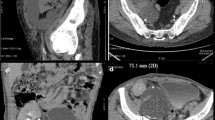Abstract
Background: Laparoscopic treatment of pelvic lymphocele secondary to kidney transplant has gained popularity in the last few years, although lesions of the urinary tract (ureter, renal pelvis, and bladder) have been reported frequently. To evaluate the result of this treatment and the associated risk of urinary tract lesions, we reviewed our experience and reports in the medical literature on open and laparoscopic surgery.
Methods: From 1991 to 1999, we laparoscopically treated 12 patients (7 men and 5 women; median age, 43 years; range, 17–59 years) with symptomatic pelvic lymphocele causing a deterioration of renal function because of compression on the ureter in 10 of the 12 patients and lymphocele compression of the iliac vein in the other 2 patients. In nine patients, the lymphocele wall was opened and sutured to the peritoneum to keep the window open. In two patients, an omentoplasty was performed, and in the remaining patient, both techniques were used. All patients were followed up clinically with ultrasound and biochemistry for a median period of 33 months (range, 1–96 months). Using Medline, we reviewed the medical literature from 1980 to 1998 and collected 252 cases in which operations had been performed to drain an internal lymphocele secondary to kidney transplantation.
Results: Laparoscopic treatment was successful in 11 of the 12 patients. One patient was converted to open surgery because of a lesion in the transplanted ureter. One patient needed repeat laparoscopy 24 hours after the operation because of bleeding from the peritoneal window. The median duration of the operation was 120 min (range, 70–200 min), and the median postoperative hospital stay was 5 days (range, 2–12 days). None of the patients needed to discontinue oral cyclosporine assumption. The serum creatinine level dropped significantly after surgery (p < 0.05). No symptomatic recurrences were observed. Of the 252 patients found in the medical literature, in 129 the procedure was performed with open surgery and in 123 laparoscopically (our 12 patients included). The prevalence of iatrogenic lesions to the urinary tract increased threefold with the use of laparoscopic surgery (from 1.6% in open surgery to 7% in laparoscopy). The recurrence rate of symptomatic lymphocele, however, decreased from 15% to 4%.
Conclusions: Laparoscopic drainage of posttransplantation lymphocele is a relatively simple method for treating this complication, although it bears the burden of an increased incidence of urinary tract lesions, as confirmed by a review of the literature. The major advantage of the laparoscopic approach is the absence of postoperative ileus with the opportunity to continue the enteral immunosuppressive regimen and a lower recurrence rate. These data suggest that laparoscopic lymphocele treatment might be considered the therapy of choice, provided the iatrogenic lesions of the urinary tract diminish as more experience with this technique is gained.
Similar content being viewed by others
Author information
Authors and Affiliations
Additional information
Received: 1 March 1999/Accepted: 1 July 1999
Rights and permissions
About this article
Cite this article
Cadrobbi, R., Zaninotto, G., Rigotti, P. et al. Laparoscopic treatment of lymphocele after kidney transplantation. Surg Endosc 13, 985–990 (1999). https://doi.org/10.1007/s004649901152
Published:
Issue Date:
DOI: https://doi.org/10.1007/s004649901152




